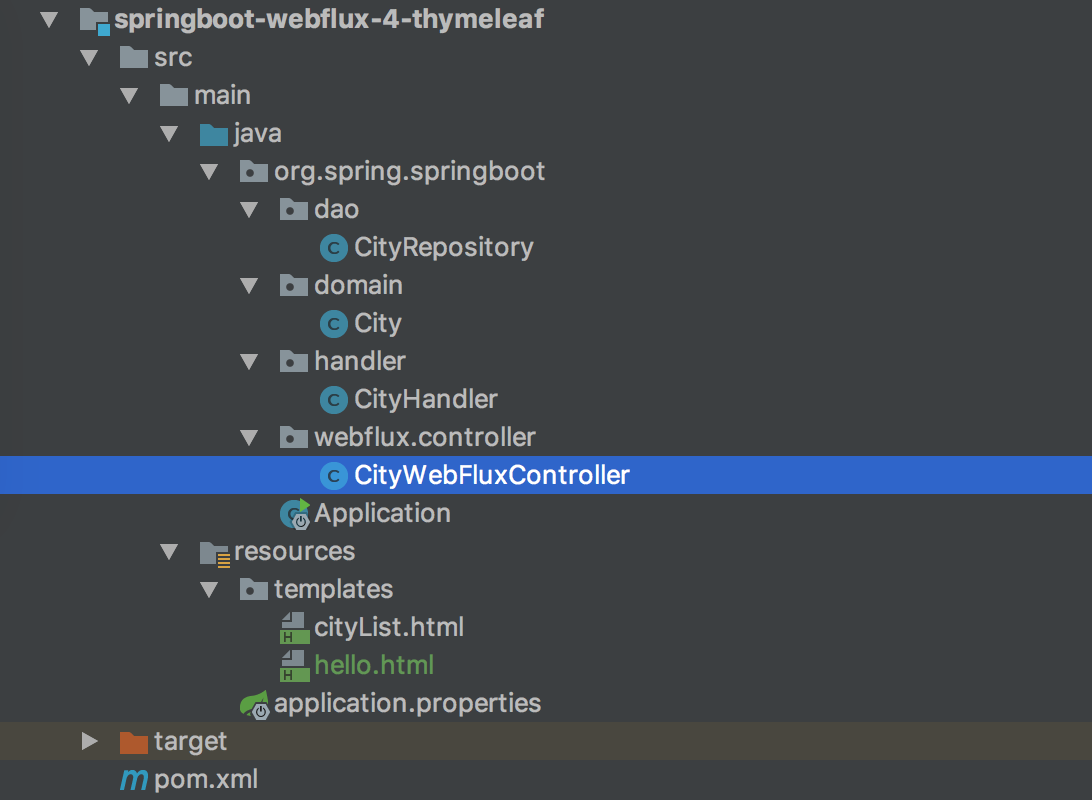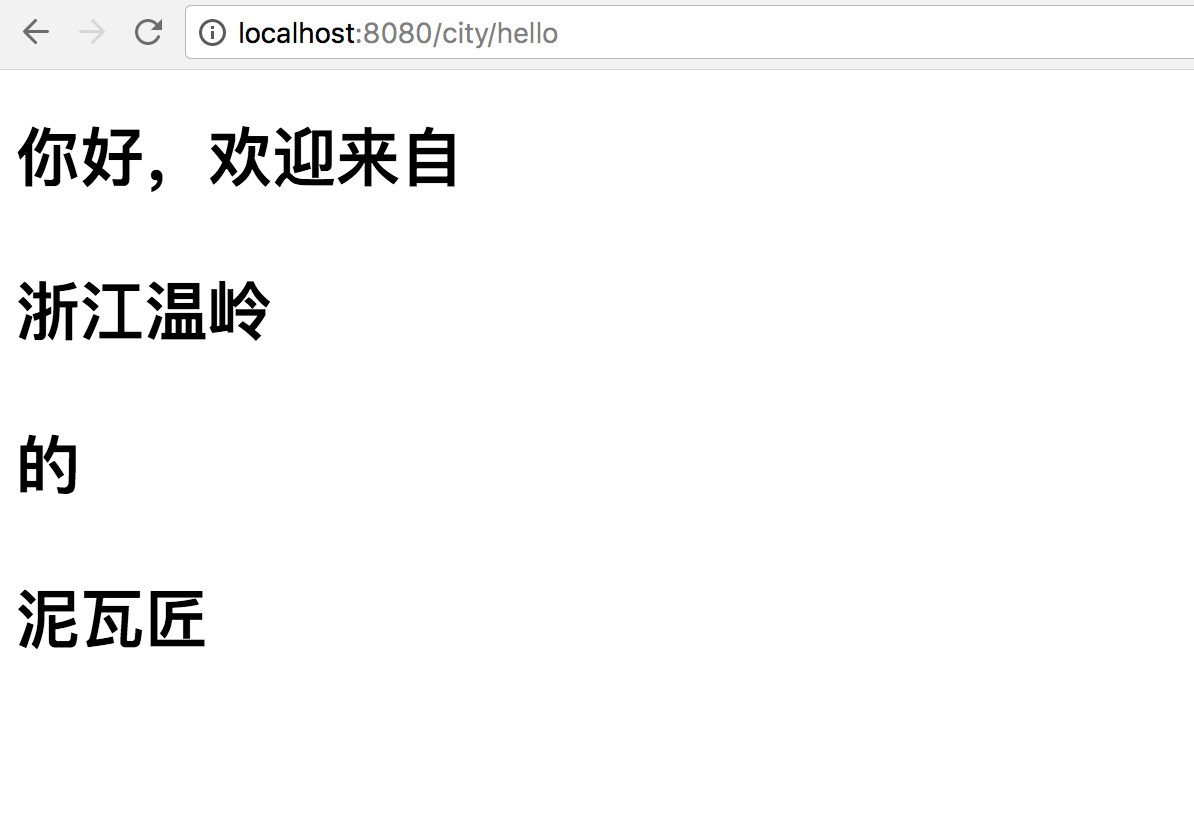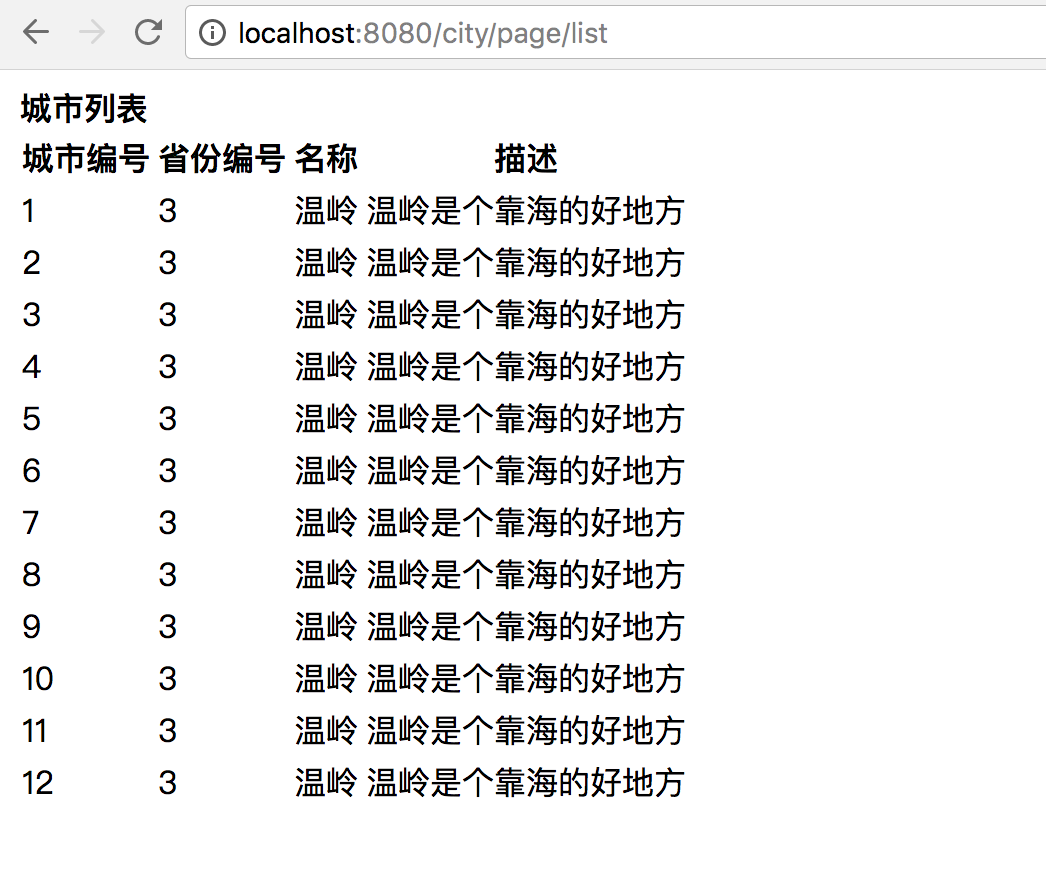05 WebFlux 整合 Thymeleaf 上一篇介绍的是用 MongoDB 来实现 WebFlux 对数据源的操作,那么有了数据需要渲染到前台给用户展示,这就是本文关心的 View 层,View 的表现形式有很多,比如 JSON 和 HTML。开发中常用模板语言很常见的有 Thymeleaf、Freemarker等,那什么是模板语言?
常见的模板语言都包含以下几个概念:数据(Data)、模板(Template)、模板引擎(Template Engine)和结果文档(Result Documents)。
- 数据
数据是信息的表现形式和载体,可以是符号、文字、数字、语音、图像、视频等。数据和信息是不可分离的,数据是信息的表达,信息是数据的内涵。数据本身没有意义,数据只有对实体行为产生影响时才成为信息。
- 模板
模板,是一个蓝图,即一个与类型无关的类。编译器在使用模板时,会根据模板实参对模板进行实例化,得到一个与类型相关的类。
- 模板引擎
模板引擎(这里特指用于 Web 开发的模板引擎)是为了使用户界面与业务数据(内容)分离而产生的,它可以生成特定格式的文档,用于网站的模板引擎就会生成一个标准的 HTML 文档。
- 结果文档
一种特定格式的文档,比如用于网站的模板引擎就会生成一个标准的 HTML 文档。
模板语言用途广泛,常见的用途如下:
- 页面渲染
- 文档生成
- 代码生成
- 所有 “数据+模板=文本” 的应用场景
Spring Boot 推荐使用的模板语言是 Thymeleaf,那什么是 Thymeleaf?
官方的解释如下: Thymeleaf is a modern server-side Java template engine for both web and standalone environments.
Thymeleaf 是现代的模板语言引擎,可以独立运行也可以服务于 Web,主要目标是为开发提供天然的模板,并且能在 HTML 里面准确的显示。
Thymeleaf 是新一代 Java 模板引擎,在 Spring 4 后推荐使用。目前是 Spring 5 自然更加推荐。
结构
类似上面讲的工程搭建,新建一个工程编写此案例,工程图如图所示:

目录如下:
- org.spring.springboot.webflux.controller:Controller 层
- org.spring.springboot.dao:数据操作层 DAO
- org.spring.springboot.domain:实体类
- org.spring.springboot.handler:业务逻辑层
- Application:应用启动类
- application.properties:应用配置文件
- pom.xml maven 配置
- application.properties 配置文件
模板是会用到下面两个目录:
- static 目录是存放 CSS、JS 等资源文件;
- templates 目录是存放视图。
本文重点在 Controller 层 和 templates 视图的编写。
新增 POM 依赖与配置
在 pom.xml 配置新的依赖:
这里我们增加了 Thymeleaf 依赖,但不用在 application.properties - 应用配置文件中配置任何配置。默认启动其默认配置,如需修改配置参考 Thymeleaf 依赖配置,如下:
spring.thymeleaf.cache=true /# Enable template caching. spring.thymeleaf.check-template=true /# Check that the template exists before rendering it. spring.thymeleaf.check-template-location=true /# Check that the templates location exists. spring.thymeleaf.enabled=true /# Enable Thymeleaf view resolution for Web frameworks. spring.thymeleaf.encoding=UTF-8 /# Template files encoding. spring.thymeleaf.excluded-view-names= /# Comma-separated list of view names that should be excluded from resolution. spring.thymeleaf.mode=HTML5 /# Template mode to be applied to templates. See also StandardTemplateModeHandlers. spring.thymeleaf.prefix=classpath:/templates/ /# Prefix that gets prepended to view names when building a URL. spring.thymeleaf.reactive.max-chunk-size= /# Maximum size of data buffers used for writing to the response, in bytes. spring.thymeleaf.reactive.media-types= /# Media types supported by the view technology. spring.thymeleaf.servlet.content-type=text/html /# Content-Type value written to HTTP responses. spring.thymeleaf.suffix=.html /# Suffix that gets appended to view names when building a URL. spring.thymeleaf.template-resolver-order= /# Order of the template resolver in the chain. spring.thymeleaf.view-names= /# Comma-separated list of view names that can be resolved.
包括常用的编码、是否开启缓存等等。
WebFlux 中使用 Thymeleaf
在 CityWebFluxController 控制层,添加两个方法如下:
@GetMapping(“/hello”) public Mono
解释下语法:
- 返回值 Mono 或者 String 都行,但是 Mono 代表着我这个返回 View 也是回调的。
- return 字符串,该字符串对应的目录在 resources/templates 下的模板名字。
- Model 对象来进行数据绑定到视图。
- 一般会集中用常量管理模板视图的路径。
Tymeleaf 视图
然后编写两个视图 hello 和 cityList,代码分别如下。
hello.html: <!DOCTYPE html> <html lang="zh-CN"> <head>
cityList.html:
<!DOCTYPE html> <html lang="zh-CN"> <head>
常用语法糖如下:
- ${…}:变量表达式;
- th:text:处理 Tymeleaf 表达式;
- th:each:遍历表达式,可遍历的对象有,实现 java.util.Iterable、java.util.Map(遍历时取 java.util.Map.Entry)、array 等。
还有很多使用,可以参考官方文档。
运行工程
下面运行工程验证下,使用 IDEA 右侧工具栏,点击 Maven Project Tab ,点击使用下 Maven 插件的 install 命令;或者使用命令行的形式,在工程根目录下,执行 Maven 清理和安装工程的指令: cd springboot-webflux-4-thymeleaf mvn clean install
在控制台中看到成功的输出:
… 省略 [INFO] ———————————————————————— [INFO] BUILD SUCCESS [INFO] ———————————————————————— [INFO] Total time: 01:30 min [INFO] Finished at: 2017-10-15T10:00:54+08:00 [INFO] Final Memory: 31M/174M [INFO] ————————————————————————
在 IDEA 中执行 Application 类启动,任意正常模式或者 Debug 模式,可以在控制台看到成功运行的输出:
… 省略 2018-04-10 08:43:39.932 INFO 2052 — [ctor-http-nio-1] r.ipc.netty.tcp.BlockingNettyContext : Started HttpServer on /0:0:0:0:0:0:0:0:8080 2018-04-10 08:43:39.935 INFO 2052 — [ main] o.s.b.web.embedded.netty.NettyWebServer : Netty started on port(s): 8080 2018-04-10 08:43:39.960 INFO 2052 — [ main] org.spring.springboot.Application : Started Application in 6.547 seconds (JVM running for 9.851)
打开浏览器,访问 http://localhost:8080/city/hello ,可以看到如图的响应:

继续访问 http://localhost:8080/city/page/list , 发现没有值,那么按照上一讲插入几条数据即可有值,如图:

总结
这里探讨了 Spring WebFlux 的如何整合 Thymeleaf,整合其他模板语言 Thymeleaf、Freemarker,就大同小异了。下面,我们可以整合 Thymeleaf 和 MongoBD 来实现一个整体的简单案例。
参考资料
https://learn.lianglianglee.com/%e4%b8%93%e6%a0%8f/%e6%a1%88%e4%be%8b%e4%b8%8a%e6%89%8b%20Spring%20Boot%20WebFlux%ef%bc%88%e5%ae%8c%ef%bc%89/05%20WebFlux%20%e6%95%b4%e5%90%88%20Thymeleaf.md
更多学习
更多实时资讯,前沿技术,生活趣事。尽在【老马啸西风】
交流社群:[交流群信息](https://mp.weixin.qq.com/s/rkSvXxiiLGjl3S-ZOZCr0Q)
